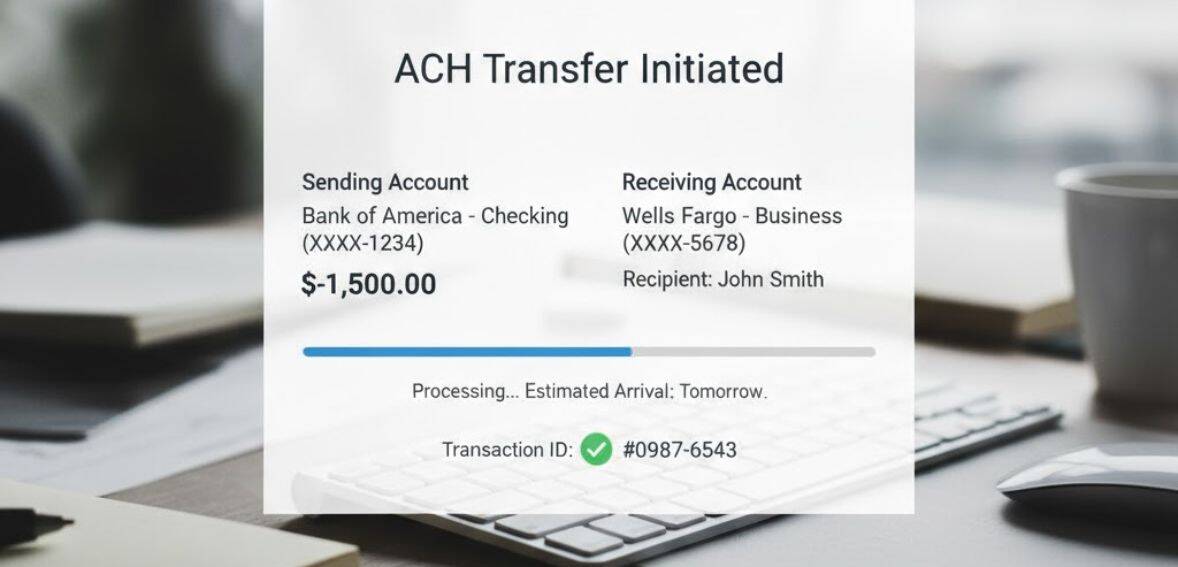
By merchantdiscount October 30, 2025
ACH transfers are a cost-effective and secure method of electronically transferring funds between banks. Rather than processing transactions in real time, ACH payments are batched at scheduled intervals, making them a more cost-effective alternative to wire transfers and checks. Both businesses and individuals use ACH for payroll deposits, bill payments, and peer-to-peer transfers.
However banks place ACH transfer limits on the account in order to maintain risk and regulations. The limitations are based on the account type, transaction reason, and banking policy. Single accounts will have lower limits but business accounts will typically support greater transfers. With knowledge of such limits and potential fees, as well as how to request a transfer boost, financial operations can proceed seamlessly.
Understanding ACH Transfer Limits

An ACH transfer limit is the maximum amount a bank allows you to send via the Automated Clearing House (ACH) Network in a single transaction or over a specific period, typically a business day. The limits are set at financial institutions in an attempt to contain the risk of fraud, control funds flow, and meet regulatory requirements.
ACH limits vary based on factors such as your bank, account type, and transaction type. For example, limits on direct deposits (payroll or government benefits) may be different from bill payments, business transactions, or taxes. Consumer accounts typically have lower ACH limits than business accounts.
Though a general amount of an ACH transfer for consumer accounts can be in the range of $6,000 a day, business accounts generally support $25,000 or even more, subject to the bank’s policy.
Since every bank sets its ACH transfer limit, a call to your bank is a good idea to find out your personal daily or monthly limit. If you need higher-than-average transfer volumes, some banks permit you to request an increase in the cap temporarily or on a long-term basis, or they can suggest an alternative payment method like wire transfers for large payments.
ACH Transfer Limitations and Fees You Need to Know

While ACH transfer limits vary across banks, there are also other important limitations, in addition to potential penalties, that you should be mindful of. Breaking these guidelines may lead to delays, extra fees, or even rejection. Some of the key things to keep in mind are listed below:
1. Cutoff Times for Processing
Banks process ACH transactions in batches at scheduled intervals throughout the day. If you make a transfer after your bank’s cutoff point, it’ll be processed the following business day. This can be frustrating if you’re facing a deadline, so it’s important to check your bank’s processing schedule in advance.
2. Insufficient Funds Fees
If you attempt an ACH transfer but do not have enough money in your account to make the transfer, your bank will charge an NSF fee. Not only will the transfer fail, but you may even be charged a fee such as a bounced check fee. Some banks also charge overdraft fees if the transfer results in a negative account balance.
3. No International ACH Transfers
ACH payments are designed for transactions within the United States. Most banks do not support international ACH transfers, meaning you’ll need to use an alternative method—such as wire transfers or online payment platforms—if you’re sending money overseas.
4. Potential for Increased Limits
Even though banks impose ACH limits to control risk, they can be negotiable for clients with an excellent account history. If you have to initiate more than your bank’s set limit, you can negotiate with a branch manager or customer service representative. In some instances, banks will approve a one-time increase of the limit or offer an alternative solution for high-value transactions.
Understanding these limits and fees can help you prevent unnecessary fees and get your ACH transfers completed without problems. Be certain to look over your bank’s policies and arrange your transactions ahead of time in order to keep any surprises out.
Factors That Affect ACH Transfer Limits

ACH transfer limits are not some random calculation—banks weigh them carefully from internal policy, risk management procedure, and regulation. Several factors drive how banks calculate these limits, including customer history, type of transaction, time, and compliance guidelines.
1. Financial Institution Policies
Banks and credit unions determine ACH transfer limits according to their risk tolerance and capacity to operate. These restrictions do not have to be the same for all customers. The bank will look at the customer’s account status, history, and relationship with the bank overall to determine what is a sufficient amount to transfer.
For example, a big commercial account customer with a stellar financial history would likely be entitled to a higher ACH limit than a new private banking account depositor. These banks also study and update these policies periodically based on new rules or changing risk factors.
2. Transaction Type
The purpose of an ACH transfer can influence your transfer limit. ACH direct deposits, such as payroll, government benefits, or tax refunds, often have higher transfer limits compared to ACH direct payments for bills, online purchases, or peer-to-peer transfers.
Private transfers also might have lower transfer limits than commercial or business transfers based upon differential risks and magnitudes in each case.
3. Timing of Transfers
When you initiate an ACH transfer, how much you can send is also determined. Same-day ACH payments, which clear more quickly, will typically have lower limits than ordinary regular next-day ACH payments.
Certain banks may also impose stricter limits on weekend or holiday transactions, during which processing is slower, and bank operations are minimized.
4. Regulatory and Risk Considerations
Banks have to follow financial laws on fraud prevention, money laundering, and unapproved transactions. There are limits set by federal regulators on ACH transfers, particularly high-risk transactions. Banks also conduct risk reviews internally in an effort to avert fraud, unauthorized withdrawal, and potential operating problems.
With an understanding of these factors, individuals and businesses can better plan their ACH transactions and, if necessary, ask their bank for higher transfer limits based on their banking history and transaction requirements.
How to Increase Your ACH Transfer Limit

If your ACH transfer limit is too low for your business or other needs, you can ask for an increase. Banks will likely consider customers’ requests separately based on factors like account history, financial health, and the reason for the transaction. This is how you can improve your chances of getting a higher limit:
1. Approach Your Bank
Start by contacting your bank—by phone, go to the office in person, or contact the bank online—to negotiate your options. Be ready to explain how a higher limit will help you and provide such information as are pertinent to your situation or future transactions. Your banker, depending on your bank, may have specific requirements for documentation, especially business transfers.
2. Keep Your Account Current
Banks check customers’ accounts from time to time and raise limits. Being up to date with your business and personal data, like income, revenues for the business, or the persons authorized to make use of the account, could simplify the process of approval.
3. Request a Temporary or Permanent Increase
If you need an increase of a one-time limit on a specific transaction, your bank will provisionally provide the adjustment. For long-term needs, you could ask for a permanent increase in limit, although approval would also be based on account maturity and transaction usage.
4. Maintain a Good Account History
Show responsible account usage—i.e., not bouncing, regular deposits, and a good banking relationship—can do much to increase your chance of having a high ACH limit. Banks are more likely to grant approvals to customers who demonstrate stability.
5. Split Big Transfers
If your request for an increase in limit is denied, you can divide your payment into a number of payments within your existing limit. Although it will take a little longer, you can make your payment without having an actual limit increase.
6. Check for Any Changes and Charges
After approval, verify all the information with your bank, such as any adjusted transfer amounts and charges. Banks will impose ACH accelerated fees or higher transfer amounts, so you’ll need to know any extra charges beforehand.
By using these steps, you’ll be able to successfully manage ACH transfer amounts and receive your financial transactions settled in a smooth manner.
How to Accept ACH Payments for Your Business

Paying with ACH payment processing has many benefits for your business such as it simplify transactions, reduce processing fees, and make paying your customers easier. To start with, the following is recommended:
Open a Business Checking Account
If you do not yet have a business checking account, you would need one to receive ACH payments. Alternatively, if you are with a payment processor or merchant services company, they can likely provide ACH payment capabilities as part of their offerings.
Enable ACH Payments in Your Payment System
Unlike credit cards and digital wallets, ACH payments do not necessarily default as a payment option. You may need to adjust your payment stream or add ACH processing via your merchant service provider. They will help you best to have ACH on your billing or checkout system implemented.
Get Customer Authorization
Prior to sending an ACH transaction, you must get express authorization from your customer. This is done through an ACH authorization form (or mandate), which gives your company the legal right to debit their bank account. This is done to prevent unauthorized transactions and ensure ACH compliance.
Get Customer Bank Information
To make an ACH payment settlement, you’ll need your customer’s bank name, routing number, and account number. It’s all securely entered into your bank portal or payment gateway beforehand in preparation for setting up the transfer.
Initiate ACH Payment
Once authorization is set and banking details are in hand, you can go ahead and initiate the ACH transaction. While some customers like sending ACH payments manually, many businesses do so themselves for regular bills, subscription, or one invoice.
Having the ability to accept ACH payments enables businesses to save transaction fees compared to credit card payments and offer a secure, low-cost solution for recurring or high-value transactions.
Conclusion
ACH transfers are a safe, efficient, and effective method of sending and receiving money electronically. Banks impose transfer limits on them for risk management and compliance purposes, but knowing these limits will enable you to plan the transactions more effectively.
In a situation where there is a need for urgency, you can request a higher limit or use a different payment method. With ACH payments, businesses and consumers can automate financial transactions without paying unnecessary fees and delays.